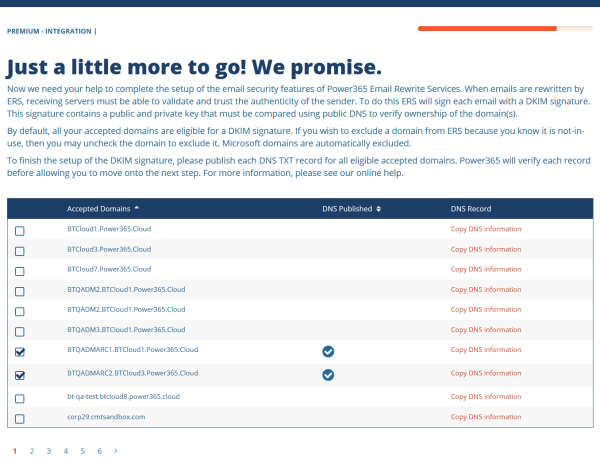DKIM
What is DKIM?
DomainKeys Identified Mail (DKIM) is an email authentication method designed to detect forged sender addresses in emails, a technique often used in phishing and email spam. DKIM allows the receiver to check that an email claimed to have come from a specific domain was indeed authorized by the owner of that domain. Wikipedia
Why is DKIM required for ERS?
A DKIM or commonly known as an Email Signature, is required for Email Rewrite Services (ERS) to ensure Domain Alignment and Authenticity. Without the proper email signature, DMARC would fail if quarantine or reject are enabled. For more information about DMARC and ERS, see this article.
When is DKIM required for ERS?
When emails are rewritten by ERS, receiving servers must be able to validate and trust the authenticity of the sender. To do this ERS will sign each email with a DKIM signature. This signature contains a public and private key that must be compared using public DNS to verify ownership of the domain(s).
By default, all your accepted domains are eligible for a DKIM signature. If you wish to exclude a domain from ERS because you know it is not-in-use, then you may uncheck the domain to exclude it. Microsoft domains are automatically excluded.
When do I choose my DKIM domains for ERS?
During project setup of the ERS components.
The project wizard will walk you through the configurations of ERS. During this process you will be asked to choose which domains will require email signatures. It is recommended any accepted domain being used by any mail-enabled object within your tenant environments be published. If the accepted domain is not in use by anyone, then it is not required. If in doubt, enable it.
How do I publish my DKIM DNS records?
It’s simple if you have access to your public DNS. In most cases, even as IT administrators we may not have direct access to update public DNS. In those cases, you’ll need to submit a change control to publish DNS TXT records for all the accepted domains. And each record must contain the public key provided in the “Copy DNS Information” action in the project wizard.
Power365® will present a unique public key associated with the domains. That key is to be published as a DNS TXT record for the selected domain. Here is an example of such a record.
Example TXT Record:
Name: selector1._domainkey.contoso.com
Type: TXT
Value: v=DKIM1; k=rsa; p=MIGfMA0GCSqGSIb3DQEBAQUXA4GNADCBiQKBgQC0uekhrGKBUmlvPXcy2XxEBG 7Hn+64l505xl0vwk3cnHwWaVw1LTFcsFxUCf2tXpNE02ap5EhCCTjGGOyEJ/ZX1ScptyDP3 X/eJDn4jq5sQQruK3F9KdU9kLTmkALK+ySz+lpX40DLXWw2BauOEzpVD65XZUwiN5DJUc 37/RcozRwIDAQAB
The Project implementer will copy this information and provide it to the team that manages DNS for this domain. Power365® will immediately begin monitoring DNS for this record. Once the DNS TXT record has been validated by Power365®, the Project implementer may select the desired domains to complete the setup.

